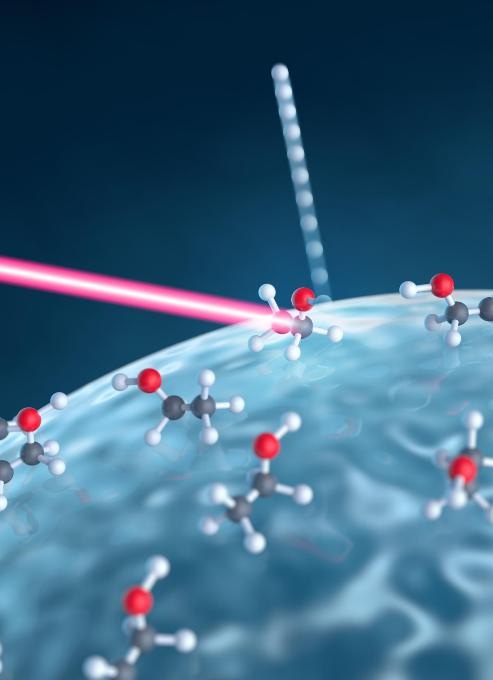Oct 14 2019
LMU Munich scientists have investigated the primary results of the interaction between light and molecules on the surface of nanoscopic aerosols.
 An intense laser pulse (red) hits a nanoparticle made of glass and interacts with molecules on its surface. Subsequently, as depicted, hydrogen ions may be detached, and the yield of such reactions can be measured by reaction nanoscopy. (Image credit: Alexander Gelin)
An intense laser pulse (red) hits a nanoparticle made of glass and interacts with molecules on its surface. Subsequently, as depicted, hydrogen ions may be detached, and the yield of such reactions can be measured by reaction nanoscopy. (Image credit: Alexander Gelin)
The nano-realm moves constantly. All natural mechanisms are eventually governed by the interaction between matter and radiation. As light hits particles, it leads to reactions. The change in the energy states of electrons causes the atoms to rearrange and the molecules to reconfigure.
Such processes significantly speed up when reactants gets absorbed on the nanoparticle surface in the atmosphere. This is a vital phenomenon for atmospheric photochemistry and hence has an effect on climate and health.
One of the light-influenced molecular processes that occur on aerosols has currently been examined in detail by scientists led by Professor Matthias Kling and Dr Boris Bergues at the Laboratory for Attosecond Physics, which is run collaboratively by the MPQ and the LMU Munich.
The team has designed a new method, known as reaction nanoscopy, which can help study basic physicochemical transitions on solid interfaces. Currently, this method has been used for characterizing the reaction of ethanol with molecules of water on the glass nanoparticle surface under the impact of high-intensity laser light.
The scientists irradiated the spherical particles using ultrashort laser pulses, each of which lasts for a few femtoseconds. A femtosecond is one-millionth of a billionth of a second. Using reaction nanoscopy, they successfully recorded this three-dimensional ultrashort interaction with nanometer resolution.
We have observed the detachment and acceleration of hydrogen ions from molecules on the surface of nanoparticles. The ability to do so forms the basis for the high spatial resolution of our imaging technique.
Dr Boris Bergues, Laboratory for Attosecond Physics
“Because the technology enables us to determine the exact position on the nanoparticle with the highest reaction yield, we can trace reactions of molecules adsorbed on the surface of aerosols with high spatial resolution,” added Matthias Kling.
These processes are universal, particularly in the areas of astrochemistry and atmospheric physics. For instance, atmospheric light interacts with aerosols and their joint molecules, inducing subsequent reactions vital to the climate development.
In the near future, the findings—published in Nature Communications, 2019—obtained using the new analytical method by the laser physicists at LMU Munich could offer a useful understanding, particularly in the field of atmospheric chemistry.